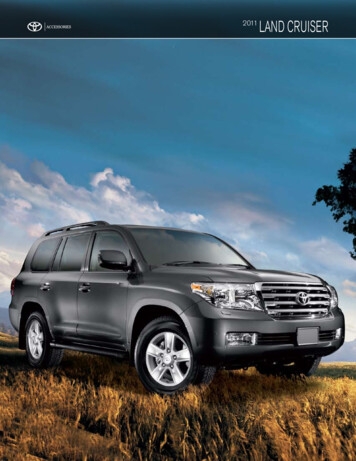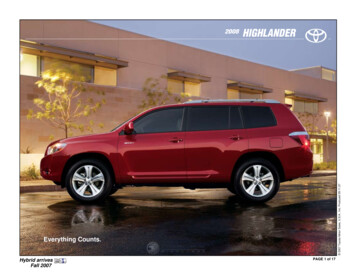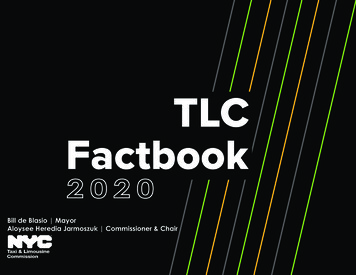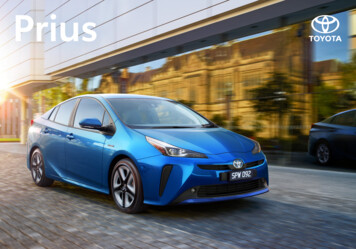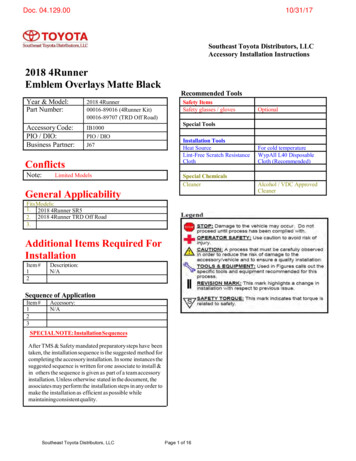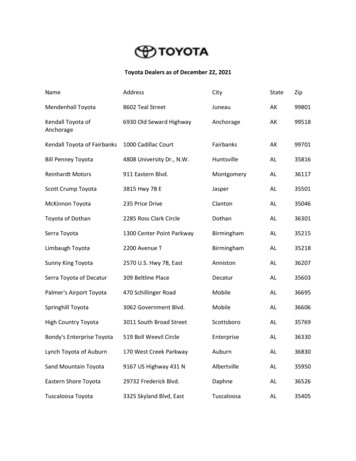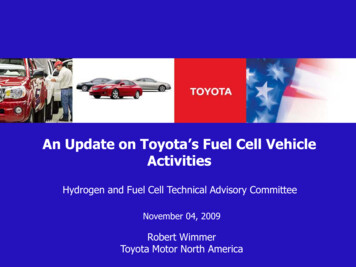
Transcription
An Update on Toyota’s Fuel Cell VehicleActivitiesHydrogen and Fuel Cell Technical Advisory CommitteeNovember 04, 2009Robert WimmerToyota Motor North America
Issues that Influence Automobile BusinessI ssuesActionPotential SolutionPetroleum SupplyEnergy & FuelDiversificationBiofuelsGreen ElectricityNatural GasClimate ChangeLife CycleCO2 ReductionImproved EfficiencyLow Carbon FuelsBalance of TradeReduceImported FuelFuels fromDomestic FeedstocksEnergy SecurityReduce Imports fromUnfriendly CountriesFuels fromDomestic Feedstocks
Hybrid is First StepTOYOTA MODELSPriusLEXUS MODELSRX450hMidsize 5 DoorLuxury SUVAveraging over 20,000 hybridssold per month in 2008HS250hMidsize SedanCamry HybridMidsize 4 DoorHighlander HybridMidsize SUVGS450hPremium Sport SedanLS600hFlagship
The Big PictureCumulative Hybrid SalesCumulative Sales in Millions2.52.01.5Global Energy Benefits to Date*Global Sales1,800,000 Over billion gallons of gasoline saved Over 10 million tons of CO2 avoided1.00.50.01997US 20072008Jan-June2009New technologies must be produced in largevolumes to make a meaningful impact*Toyota Estimate
Comparison of Energy l*150%Well-to-Wheel20%Natural gasFCHV-advReforming withmembraneseparation67% *259%*140%40%Hydrogen (70MPa)Natural gasEVCombined cyclepowergeneration39%85%33%ElectricityGasoline HV(Prius)Gasoline ICECrude oilRefineGasolineCrude oilRefine40%84%84%23%34%19%Gasoline*1 Tank-to-Wheel efficiency: measured in the Japanese 10-15 test cycle*2 Difference of Well-to-Tank efficiency between 35MPa and 70MPa: approx. 2%(Toyota Calculation)FCs are tough to beat for well-to-wheels efficiency
Toyota FCHV ProgressPresent2015FCCJ* / DOE TargetCommercializationConference of JapanVehicleDec. 2002 ’02 FCHV(lease model)Jul. 2005 ’05 FCHV(lease model)TechnicalChallenges1. Cold Start / DrivingCapability0degC 0degC 2. Actual CruisingRange210km230km3. FC Stack Durability4. Cost reduction’08 FCHV-adv(lease model)CommercialIntroductionMassProduction* Fuel Cell-30degC500km or more15 years or more1/10 or less(design / materials)Toyota is making excellent progress resolving technical challenges
FCHV-adv*1 in LA#4 cycleOverall length/ width/ height4,735/ 1,815/ 1,685(mm)Max. speed (mph)Vehicle Cruising range (mile)96455*1Fuel economy (mile/kg H2) 72.4 *1TypeFuelPure hydrogenStorage system High-press. H2 tankMax. storagepressure (MPa) 70Tank capacity6.0 (35 degC)(kg H2)
Fuel Cell System TechnologyHybrid TechnologyPower control unitTOYOTAFC StackMotorBatteryHigh pressurehydrogen tankFuel Cell System Technology
Key Technical Challenges for FC VehiclesC. Stack durabilityB. Freeze startcapabilityD. Cost &power densityA. Cruising range
60On-board H2 94%55FCHV-adv50 Fuel economyFCHVη: Vehicle efficiency (LA#4)(137miles,η 46%)2.03.0FCHV-advLA#4455 milesJapanese10・15in-house test516 miles(329miles,η 58%) 23%45Test cycle4.05.0On-board H2 (kg)FCHV-adv has achieved anpractical cruising range ofwell over 300 miles6.07.0FCHV-adv: improved FCsystem efficiency at all loadsIncreased regenerative energyImproved vehicle efficiency(fuel economy)FC system efficiency (%)Toyota in-house test cycle6564%6040FCHV-advFCHV200Practical fuel economy (mile/kg)Cruising Range Improvement0204060Load (%)
FCHV-adv Real-World RangeRush Hour in Los Angeles 2 FCHVs Over 400 miles / tank 68.3 miles/kg of H2Fairbanks to Vancouver 2300 miles Over 300 miles / tank No mechanical problems
Key Technical Challenges for FC VehiclesC. Stack durabilityB. Freeze startcapabilityD. Cost & powerdensityA. Cruising range
Demonstrated Cold Start Capability外気温[ ]AmbientAir Temp.Timmins, Canada(degCdegC)1010Ambient Air Temperature at Timmins32002010- -10 C20- -200-2030- -3040- llowknife, CanadaDateCold weather performance similar to conventional vehicles
Cold Start CountermeasuresAmount of water in a cellManagement of water when starting at subfreezing temperatureA) PurgeFail to exceed0 degCExceed 0 degC Fail to start Succeed instartingB) Increase waterstorage capacityWater storage capacityC) Accelerate stacktemperature riseAfterShutdownAfterpurgingAfter starting@ 0deg C: Amount of generated water beforeexceeding 0 degCMeasures important for cold start capability:A) Optimum purge to reduce remaining waterB) Increase of water storage capacityC) Accelerating stack temperature rise
Key Technical Challenges for FC VehiclesC. Stack durabilityB. Freeze startcapabilityD. Cost & powerdensityA. Cruising range
MaximumOutputCrossoverAmountToyota FC Stack Durability0Stack DurabilityMEA1Reductionof physicaldeteriorationMEA2Reductidet on ofe riora chemition calThresholdlimit valueMEA3MEA4Thresholdlimit valueMEA1MEA3MEA4MEA251015Durability (year equivalent)20MEA durability is steadily improving under real-world conditions25
FC System DurabilityDriving Cycle Pattern of TestAverage speed : 40 mile/hSpeed [ km/h ]System Output [ % ]1009030 min / cycle80312,000 mile;25years equivalent70FC system Bench600100,000200,000Running Distance300,000[ mile ]Testing indicates linear degradation to the equivalent of 25 years
Degradation During Start-up & Shutdown1. Degradation due to potential change at starting0V 0.85V9080VOC85Cell Voltage [V]95 0VStack output [%]100Start of operation1.00.850TimeNumber of Start & StopVotage at start-up and shutdown must be managed
Cold Start Degradation100Stack output [%]95Deteriorated80 condition (sample)90Catalyst er of ON/OFF at subfreezing temp.Must minimize degradation from cold starts400
FC Stack Durability SummaryConfirmed system durability of FCHV-adv: 25-year equivalent durability on crossover Approximately 70% of initial performance after the equivalent of25 years operationNext steps:Develop countermeasures to enhance durability Reduce start/stop and cold start degradation Confirm correlation between laboratory and field test data
Key Technical Challenges for FC VehiclesC. Stack durabilityB. Freeze startcapabilityD. Cost & powerdensityA. Cruising range
FCHV Cost Reduction1/101/10’05 ModelFCHV’08 ModelFCHV-advResolvingtechnical issuesModelgenerationModelgenerationReducing costsBy innovativedesign, material,manufacturingBy mass productionengineering
Approaches to FCHV Cost Reduction(1) Design1. Simplify the system2. Downsize and reduce weightof FC stackTOYOTA FCHV(2) Materials:Reduce the cost of FC-systemspecific materials Important to cooperate withmaterials manufacturers(3) Improve production technology
FC Stack Cost Reduction(1) Design: Downsize & reduce weight(minimize materials)Cell Voltage [V]TOYOTA FC StackCurrent density x2with ½ electrode area Halve cell materials usedMax. outputCurrent Density [A/cm2]1. Increase output density2. Reduce number of parts3. Improve joint/seal method4. Decrease Pt catalyst loading(2) Material: Improve durability & reducecost1. Electrolyte membrane2. Separator (incl. surface treatment)3. GDL, etc.
Electrode Catalyst “Trilemma”- Improvement of catalyst activity- Crossover reduction- Contact resistance reduction- Improvement of proton conductivityCell Voltage (V)EfficiencyGoal-Improvement of gas diffusivity-Water managementCurrent StatusPower DensityTrilemma of Electrode Catalyst(1) Reduction of precious metal amount (Pt 1/10)(2) Higher performance(High voltage / High output density)(3) Durability improvement(200,000km for 15 years or more)Current Density (A/cm2)Must solve electrode catalyst “trilemma” to achieve FC stack cost targets
Hydrogen Tank Cost ReductionCFRP(for resistance to H2 gaspressure)ØDLiner(for H2 sealing)LCross-section of tank body(1) Reduce CFRP used (by making thinner)Tank dimension- Optimize laminar structure (hoop winding / helical winding)- Optimize L/D- Optimize boss size(2)Reduce cost of CFRP- Aviation grade general-purpose grade- Develop low-cost CFRP for high-pressure tank
Development of Production Technology(1) Web handling technology(2) One-by-one handling technologyTransfer directionTransfer robotBernoulli ChuckSlipCell@ transfer speed 50m/min.RevolutionindicatorAfter transfer(3) 70 MPa hydrogen tankBefore transfer
Progress of FC Technology DevelopmentBasic researchCommercializationValley of deathSource of pictures: each automaker’s web site (excluding TOYOTA FCHV)FC development is more than half way over the “Valley of Death”
Steps for CommercializationProductionDelivery, SupplyVehicleSolar / biomassCoalPetroleumNatural GasHydrogenatedcompoundsHydrogen Transportation Method Infrastructure Development Codes & Standards Hydrogen Delivery CostGovernment, Energy SuppliersIssues Production Storage method CO2 Stabilization CostIssuesIssuesElectricity Stack Durability Power Density Freeze Start Capability Driving Range Vehicle CostCar makers
California Infrastructure ConcernAssumption:One H2 station serves 25 FC vehicles18016040001401203000Expected FC Vehicle# based oncurrent ZEV requirement1008020006040100020Expected H2 Station #and Capacity ( serving vehicle #)2014201020082006200420020200002012# of H2 Stations5000# of vehicles, OEMs totalH2 Station Capacity200YearBy the 2012, the demand for H2 stations will far exceed supply if stationdeployment is not accelerated
Conclusions Hydrogen is one of the future fuels Toyota is pursuing We continue to devote considerable resources tobringing a FC vehicle to market in the 2015 time frame– Cold start & range issues are mostly resolved– Durability & cost challenges remain “Green” fuels and high volumes are required formeaningful GHG benefit Deployment of hydrogen refueling infrastructure mustaccelerate for fuel cell vehicles to succeed
Thank You!
Highlander Hybrid Midsize SUV Averaging over 20,000 hybrids sold per month in 2008. Prius Midsize 5 Door RX450h Luxury SUV HS250h Midsize Sedan. Cumulative Hybrid Sales 0.0 0.5 1.0 1.5 2.0 2.5 . An Update on Toyota's Fuel Cell Vehicle Activities Subject: Presented at the HTAC Open Meeting in Arlington, Virginia, on November 4-5, 2009 .
